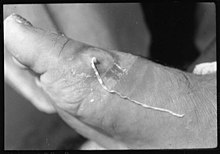
Back ድራኩንሱሊአሲስ Amharic داء دودة غينيا Arabic داء دودة جينيا ARZ Дракункулёз Byelorussian Дракункулоза Bulgarian Bolest gvinejskog crva BS Dracunculosi Catalan Drakunkulóza Czech Nyalifu DAG Dracontiasis German
| Dracunculiasis | |
|---|---|
| Other names |
|
 | |
| A D. medinensis worm emerges from a wound on a person's foot | |
| Specialty | Infectious disease |
| Symptoms | Painful blister that a long white worm crawls out of |
| Usual onset | One year after exposure |
| Causes | Ingesting Guinea worm-infected copepods, drinking contaminated water |
| Prevention | Preventing those infected from putting the wound in drinking water, treating contaminated water |
| Treatment | Slowly extracting worm, supportive care |
| Frequency | 14 cases worldwide (2023)[1] |
| Deaths | ~1% of cases |
Dracunculiasis, also called Guinea-worm disease, is a parasitic infection by the Guinea worm, Dracunculus medinensis. A person becomes infected by drinking water contaminated with Guinea-worm larvae that reside inside copepods (a type of small crustacean). Stomach acid digests the copepod and releases the Guinea worm, which penetrates the digestive tract and escapes into the body. Around a year later, the adult female migrates to an exit site – usually the lower leg – and induces an intensely painful blister on the skin. Eventually, the blister bursts, creating a painful wound from which the worm gradually emerges over several weeks. The wound remains painful throughout the worm's emergence, disabling the affected person for the three to ten weeks it takes the worm to emerge.
There is no medication to treat or prevent dracunculiasis. Instead, the mainstay of treatment is the careful wrapping of the emerging worm around a small stick or gauze to encourage and speed up its exit. Each day, a few more centimeters of the worm emerge, and the stick is turned to maintain gentle tension. Too much tension can break and kill the worm in the wound, causing severe pain and swelling. Dracunculiasis is a disease of extreme poverty, occurring in places with poor access to clean drinking water. Prevention efforts center on filtering drinking water to remove copepods, as well as public education campaigns to discourage people from soaking affected limbs in sources of drinking water, as this allows the worms to spread their larvae.
Accounts consistent with dracunculiasis appear in surviving documents from physicians of Greco-Roman antiquity. In the 19th and early 20th centuries, dracunculiasis was widespread across much of Africa and South Asia, affecting as many as 48 million people per year. The effort to eradicate dracunculiasis began in the 1980s following the successful eradication of smallpox. By 1995, every country with endemic dracunculiasis had established a national eradication program. In the ensuing years, dracunculiasis cases have dropped precipitously, with 14 cases reported worldwide in 2023.[1] 15 previously endemic countries have eradicated dracunculiasis, leaving the disease endemic in four countries: Chad, Ethiopia, Mali, and South Sudan. If the eradication program succeeds, dracunculiasis will become the second human disease eradicated, after smallpox. D. medinensis can also infect dogs, cats, and baboons, though animal cases are also falling due to eradication efforts. Other Dracunculus species cause dracunculiasis in reptiles worldwide and in mammals in the Americas.
- ^ a b "Update: 14 human cases of Guinea worm reported in 2023". The Carter Center. 6 March 2024. Archived from the original on 10 March 2024. Retrieved 19 April 2024.
© MMXXIII Rich X Search. We shall prevail. All rights reserved. Rich X Search